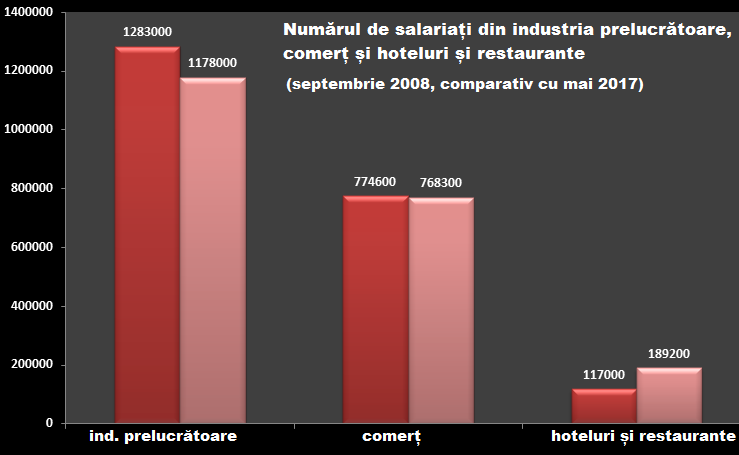*
- Number of employees in the manufacturing industry, trade and hotels and restaurants (Sep 2008, compared to May 2017)
*
In May 2017, the number of employees in Romania returned to the level recorded at the beginning of the great recession – September 2008.
Since the start of the crisis, Romania has lost almost 740,000 jobs, by May 2011, the month with the lowest number of employees – 4,095 million employees with an employment contract (fixed or indefinite).
Jobs recovered differently depending on the economic activity and the analyses shows that job creation was more accelerated in consumption-related segments (trade, hotels and restaurants) than in the manufacturing industry.
As a matter of fact, in trade, hotels and restaurants, sectors with low paid and very unsafe jobs (the first to disappear in a possible new crisis), the recovery was complete overall, while in the manufacturing sector the number of employees still did not reach the level registered before the crisis.
Manufacturing industry
In September 2008, according to INS, 1,283 million people were employed in the manufacturing sector. By May 2017, the number of employees failed to recover to the same level – 1,178 million people were employed in the field.
There have been some significant staff increases in high value-added activities in the manufacturing industry:
- computers and electronic and optical products manufacturing – number of employees increased from 25,900 to 34,200 people
- motor vehicles, trailers and semi-trailers manufacturing – from 126,800 to 197,600 employees
- electrical equipment manufacturing – number of employees in May 2017 exceeded the level of 2008 – 48,100 persons, compared to 38,600
- the number of employees in the manufacturing segment of basic pharmaceuticals and pharmaceutical products has increased very slightly – from 9,000 to 10,700 people
As for the other fields, though, the staff increased in:
- food industry – from 158,900 to 164,500 people
- textile products manufacturing (from 32,300 to 38,400) but insufficient to cover the loss of staff in the clothing manufacturing (from 205,100 to 124,800 people)
Manufacturing activities where jobs lost in the crisis have not been recovered:
- Manufacture of machinery and equipment n.e.c.– out of 65,700 jobs in 2008, there were only 52,400 in May
- Manufacture of fabricated metal products, except machinery and equipment – decrease from 99,700 to 76,900 persons
- Manufacture of furniture – 70,200 people in 2008, compared to 61,200 in 2017
- Manufacture of chemicals and chemical products- saw a reduction in number of employees from 35,200 to 25,400 persons
Increases: in trade, hotels and restaurants
While the manufacturing industry still has to recover what it lost during the crisis, these two sectors, trade and HORECA together exceeded the number of employees they had in 2008.
In September 2008, there were 774,600 employees in the trade sector, and in HORECA – 117,000 people, that is a total of 891,600 employees.
At the end of May 2017, the number of employees was:
- 768,300 employees employed in the trade sector
- 189,200 people in the hotel and restaurant industry
That is, 957,500 employees, more than in the pre-crisis interval.
Also related to the consumption increase, the number of employees in the entertainment, cultural and recreational activities increased – from only 39,800 in September 2008 to 65,100 in May 2017.
Evolution of the number of employees in other areas:
- number of employees in health and social care sector has slightly increased – from 363,800 to 369,000 people
- construction industry, the field with the sharpest fall (from 424,600 employees in September 2008, it declined to only 288,400 in January 2011), reached in May 2017 388,500 employees.
- agriculture, hunting and related services also have now more employees – the staff increased from 74,200 to 82,900 people










